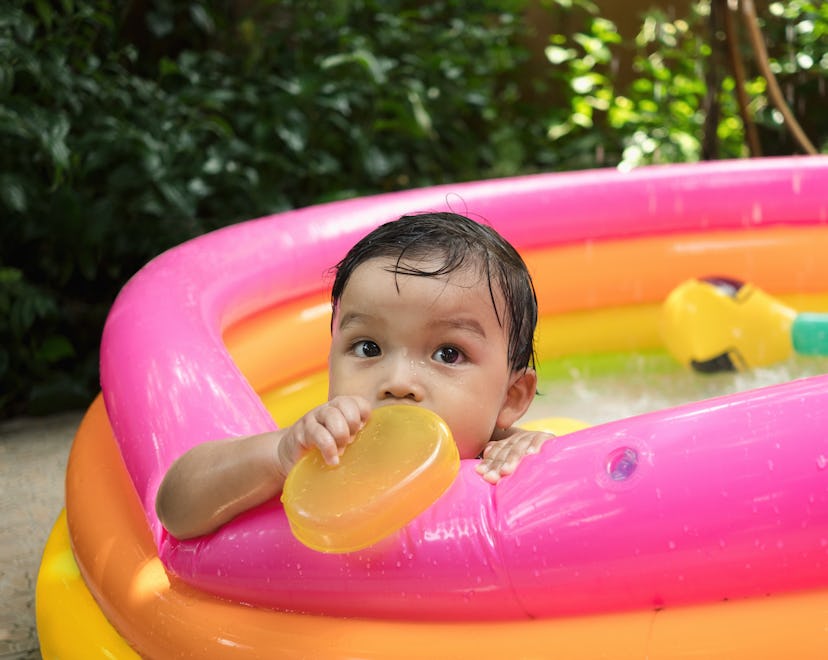Summer

You're Probably Leaving Water In The Kiddie Pool For Too Long
But don’t panic: it’s an easy task to do each day.
Have you ever felt like the minute you've finished filling up the kiddie pool with water, your kid suddenly loses interest and is ready to move on to the next activity? At that point, you might be wondering how long you can leave water in a kiddie pool without having to worry about it turning into a bacteria bath. When you factor in how your little one will inevitably melt down if you drain it in front of them (whether they had any intention of going back in or not), is it OK to just leave it be for a few days?
Since kiddie pools don't have pumps and you can't treat a few buckets’ worth of water with chlorine, you can end up with a stagnant, swampy mess before too long. But exactly how long can you leave the water in your kiddie pool before it's time to dump, clean, and refill? The answer will make your back hurt: Kiddie pools should be drained or emptied after every use, according to the Centers for Disease Control and Prevention (CDC).
What Happens If You Leave Water In A Kiddie Pool For Too Long?
"Leaving pool water out too long or not cleaning the pool appropriately between uses increases the risk of infection by a 'recreational water illness,'" pediatrician Colin Orr, M.D., tells Romper via email, which "can lead to an upset stomach and diarrhea."
If you've never heard the term "recreational water illness" before, consider yourself blessed. The term refers to those nasty bugs you can pick up from places like public pools, the beach, or the water park. Try as you might, it’s bound to happen at least once during your kiddo’s childhood, and it can be downright disastrous to endure.
These infections are caused by "E. coli, Shigella, and Cryptosporidium [and] are easily spread," pediatrician Dr. Whitney Casares tells Romper. This is particularly true "when kids swallow or come in contact with water in kiddie pools." There is an even greater risk of exposure to these germs "when [the pool] is used by more than one child at a time," she notes.
How To Keep Kiddie Pool Water Safe
Before you start thinking you might be better off spraying your kids with the hose and calling it a day, it's actually not that hard to keep an inflatable or plastic pool safe, provided you follow a few basic tips.
Dr. Orr recommends that parents give their kiddos a bath before they get in to keep contaminants to a minimum. It’s also important to immediately remove all children and water from the pool if there's any type of "accident" (particularly of the poop variety). Kids should avoid getting pool water in their mouths, according to the CDC. (Good one, CDC. Let’s see you keep two toddlers from simultaneously dunking their heads in with open mouths.)
Experts also recommend that children harboring any sort of lingering stomach bugs or other contagious illnesses should also avoid swimming with other kids. This may not be the most pleasant question to ask another parent before inviting their kid over for a kiddie pool playdate, but it’s necessary to keep everyone healthy.
How Long Is Too Long To Wait Before You Dump The Water?
Even if all of the proper precautions have been taken prior to your child’s swim session, it’s still necessary to switch out the water in your kiddie pool after each use. After your pool is drained, Dr. Orr says to clean it completely, allow it to dry, and then set it in the sun for at least four hours before using it again.
It's not uncommon to see coverings on kiddie pools that are left out overnight, but does the use of a cover change the amount of time that the water can be safely left in? Alas, "using a tarp cover does not increase the length of time water should be allowed to sit in a kiddie pool," Casares says.
Additionally, if you've heard parents talk about using chlorine tablets or bleach solutions as a way to keep kiddie pool water clean, the CDC says this isn't a "practical" way to kill germs in small pools because "the chlorine dose cannot be easily determined or safely monitored to ensure that the right amount of chlorine continuously stays in the water."
If you want to avoid the daily kiddie pool dump and refill routine, it might be worth the investment to purchase a larger pool with a filter instead. The CDC guidelines indicate that "medium and larger-sized inflatable and plastic pools that cannot be emptied daily should have filters and appropriate disinfection systems that meet the same codes and requirements as full-sized swimming pools.” So, more effort maybe, but less wasting of water.
Kiddie pools might seem a lot more high maintenance than they used to be, but they're no doubt a lot cleaner, too — which also means your kids are healthier. Just remember, no amount of fun in the sun is worth a "recreational water illness" (gross) and the up-all-night pukefest that such an ailment is inclined to bring.
Experts:
Whitney Casares, M.D., M.P.H., author of The New Baby Blueprint: Caring for You and Your Little One and founder of www.modernmommydoc.com
Colin Orr, M.D., pediatrician
This article was originally published on